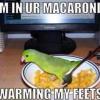Hi all.
Do you know the requirement or regulation about the sulphur dioxide content in wine in the US.?
Best Regards,
Xugang

Posted 10 November 2016 - 06:51 AM
Hi all.
Do you know the requirement or regulation about the sulphur dioxide content in wine in the US.?
Best Regards,
Xugang
Posted 10 November 2016 - 10:36 AM
Hello Xugang
See below the USA labelling requirement with regards to the declaration of allergens on wine labels:
ALLERGEN DECLARATION
(a) At present only the sulfite declaration is mandatory. However, eight other major food allergens may voluntarily be declared and a notice proposing to make this obligatory has been issued. As this proposal is in the comments phase (which phase might be extended), could look different in its final form, and one would hope that a final notice will provide for a phasing in period, it is not recommended that labels be amended at this stage. Should you, however, wish to do so, details are supplied below.
(b) For wine containing 10 or more parts per million of sulfur dioxide, the statement "Contains sulfites" or "Contains (a) sulfiting agent(s)" or identification of the specific sulfiting agent(s) is required. If your wine does not have the sulfite statement, a sample analysis by the TTB (Alcohol and Tobacco Tax and Trade Bureau, U.S. Department of the Treasury) or a TTB certified laboratory is required as proof that the wine has less than 10 ppm sulfur dioxide.
© The eight major food allergens (whether present in fining or processing agents or not and including proteins derived from them) are:
An allergen declaration could, thus, look as follows: "Contains sulfites, milk, egg and fish". You can not use terms such as "casein", "albumen" or "isinglass" or talk of "fish products" and the like or of "processing or fining agent.
Regards
Wine Gum
Posted 11 November 2016 - 03:32 AM
Hello Xugang
See below the USA labelling requirement with regards to the declaration of allergens on wine labels:
ALLERGEN DECLARATION
(a) At present only the sulfite declaration is mandatory. However, eight other major food allergens may voluntarily be declared and a notice proposing to make this obligatory has been issued. As this proposal is in the comments phase (which phase might be extended), could look different in its final form, and one would hope that a final notice will provide for a phasing in period, it is not recommended that labels be amended at this stage. Should you, however, wish to do so, details are supplied below.
(b) For wine containing 10 or more parts per million of sulfur dioxide, the statement "Contains sulfites" or "Contains (a) sulfiting agent(s)" or identification of the specific sulfiting agent(s) is required. If your wine does not have the sulfite statement, a sample analysis by the TTB (Alcohol and Tobacco Tax and Trade Bureau, U.S. Department of the Treasury) or a TTB certified laboratory is required as proof that the wine has less than 10 ppm sulfur dioxide.
© The eight major food allergens (whether present in fining or processing agents or not and including proteins derived from them) are:
- Milk (usually casein used as a fining agent)
- Egg (usually lysozyme/albumen)
- Fish (usually fish gelatin or isinglass used as a fining agent)
- Crustacean shellfish - the name of the species of crustacean shellfish (for example, crab, lobster or shrimp) must be declared.
- Tree nuts - the name of the specific type of nut (for example, almonds, pecans or walnuts) must be declared.
- Wheat
- Peanuts
- Soybeans
An allergen declaration could, thus, look as follows: "Contains sulfites, milk, egg and fish". You can not use terms such as "casein", "albumen" or "isinglass" or talk of "fish products" and the like or of "processing or fining agent.
Regards
Wine Gum
Hi Gum,
Thank you so much. Is there any detailed information about the maximun of sulfite in wine in the US? And you mentioned a proposal("this proposal is in the comments phase "), so is there a regulation or rules about the amout of sulfite in wine in the US now or before?
Thank you and waiting for your reply.
Best Regards,
Xugang
Posted 11 November 2016 - 04:39 AM
Hi Xugang
I am speaking under correction, but I think it is 60 mg/l maximum free sulpher. I will double check and come back to you on this.
Wine Gum
Posted 11 November 2016 - 05:31 AM
Kind Regards,
Charles.C
|
Thanked by 1 Member:
|
|
Posted 11 November 2016 - 06:21 AM
Thanks Charles,
I browsed the thread and the links. It seems that all passages are stressed that wine with more than 10 mg/liter must have a "Contains Sulfites" warning label, but i can't find a specific number about the amout of so2. ![]()
Anyway, thank ypu again.
Posted 11 November 2016 - 08:05 AM
The specification that we work on (as set by the South African Liquor Act) is as follows:
Wine may not contain more than 160 mg/l total sulphur dioxide. Not more than 60 mg/l of the sulphur dioxide of bottled wine shall be in the form of free sulphur dioxide
Wine destined for export in bulk, must contain at least 30 mg/l of free sulphur dioxide.
Natural wine with a residual sugar content of more than 5 gram per litre shall contain a maximum of 200 mg/l of sulphur dioxide.
I think the best is to contact your agent/distributor to find out about the requirements for the USA.
|
Thanked by 1 Member:
|
|
Posted 11 November 2016 - 09:53 AM
The specification that we work on (as set by the South African Liquor Act) is as follows:
Wine may not contain more than 160 mg/l total sulphur dioxide. Not more than 60 mg/l of the sulphur dioxide of bottled wine shall be in the form of free sulphur dioxide
Wine destined for export in bulk, must contain at least 30 mg/l of free sulphur dioxide.
Natural wine with a residual sugar content of more than 5 gram per litre shall contain a maximum of 200 mg/l of sulphur dioxide.
I think the best is to contact your agent/distributor to find out about the requirements for the USA.
Hi, Gum.
Thanks a lot for your kind help.
Best Regards,
Xugang
Posted 11 November 2016 - 02:51 PM
Thanks Charels,
I browsed the thread and the links. It seems that all passages are stressed that wine with more than 10 mg/liter must have a "Contains Sulfites" warning label, but i can't find a specific number about the amout of so2 allowed in wine in the US.
Anyway, thank ypu again.
Hi Xugang,
Sorry, i misunderstood yr OP.
The (ambiguous) answer for foods seems to be as given in the link below (assuming that wine is within it's scope).
http://www.accessdat...cfm?fr=182.3862
There may be an Industry Best Practice (shame?) which will self-limit the SO2 level necessarily shown on the Label ?
After further searching, seems that wine(s) do have some legal limits -
In Europe legal limits for Red wines: 160mg/L, White/Rose wines: 210mg/L and Sweet wines: 400mg/L, US legal limits: 350mg/L and Australia 250mg/L. Naturally occurring levels of SO2 in wines are usually found around 10-20mg/L. All wines containing sulphites greater than 10mg/L must have a statement added to the label making the consumer aware that sulphite in present.
http://www.scientist...l-sulphite-wine
(source of the data not given)
Data for wine in various locations and sources is given in the document attached below. The sourced (CFR) limit for USA seems to concur with the value in previous quote.
 SO2 content in wines,2011.pdf 843.11KB
21 downloads
SO2 content in wines,2011.pdf 843.11KB
21 downloads
Kind Regards,
Charles.C
|
Thanked by 2 Members:
|
,
|
Posted 14 November 2016 - 02:03 AM
Hi Xugang,
Sorry, i misunderstood yr OP.
The (ambiguous) answer for foods seems to be as given in the link below (assuming that wine is within it's scope).
http://www.accessdat...cfm?fr=182.3862
There may be an Industry Best Practice (shame?) which will self-limit the SO2 level necessarily shown on the Label ?
After further searching, seems that wine(s) do have some legal limits -
http://www.scientist...l-sulphite-wine
(source of the data not given)
Data for wine in various locations and sources is given in the document attached below. The sourced (CFR) limit for USA seems to concur with the value in previous quote.
Thank you so much,Charels! This is exactly what I wanted.
Food Safety Topics →
Labeling →
Labelling af flavor in the USStarted by FoodSafety_KSL, 16 Feb 2024 |
|

|
|
Food Safety Topics →
Labeling →
Labeling caffeine in Guarana extractStarted by Emily Xu, 08 Apr 2022 |
|

|
|
Government Regulatory →
CFIA - Canadian Food Inspection Agency →
Labelling US Pork Meat Product?Started by rishikasainiwork@gmail.com, 26 Nov 2021 |
|

|
|
Community General Discussion →
Community General Chat →
Winery - Alcohol Manufacturers - Are you out there?Started by Wine_QT, 14 May 2020 |
|

|
|
Government Regulatory →
CFIA - Canadian Food Inspection Agency →
Safe Food for Canadians Regulations (SFCR) →
Do organic imports from US to Canada require certification paperwork?Started by arahman, 12 Dec 2019 |
|

|
0 members, 0 guests, 0 anonymous users